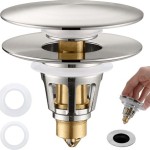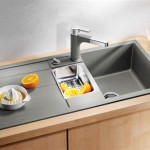How to Clean a Black Quartz Sink
Black quartz sinks offer a sleek and modern aesthetic to any kitchen. Their durability and resistance to scratches and stains make them a popular choice. However, their dark color can also make water spots, soap scum, and mineral buildup more noticeable. Maintaining the pristine appearance of a black quartz sink requires regular cleaning and the use of appropriate cleaning methods. This article provides a comprehensive guide on how to effectively clean and maintain a black quartz sink, ensuring its longevity and beauty.
Daily Cleaning and Maintenance
The foundation of keeping a black quartz sink looking its best is consistent daily cleaning. This proactive approach prevents the accumulation of stubborn stains and buildup that necessitate more intensive cleaning methods. A simple daily routine, performed after each use of the sink, can significantly extend the sink's lifespan and preserve its visual appeal.
Begin by rinsing the sink thoroughly with warm water. This initial step removes loose food particles and debris, preventing them from drying and adhering to the sink's surface. Use a soft sponge or cloth to wipe down the entire sink basin, paying particular attention to areas prone to water spots and food residue. A mild dish soap solution can be used for this step, ensuring the removal of grease and grime. The solution should be diluted in warm water to avoid excessive soap buildup.
After washing, rinse the sink again thoroughly with warm water to remove all traces of soap. Excess soap residue can dull the sink's surface and contribute to the formation of water spots. Finally, dry the sink completely with a clean, dry microfiber cloth. This step is crucial for preventing water spots, which are especially visible on dark surfaces. The microfiber cloth's absorbent properties ensure a streak-free and shiny finish.
Avoid using abrasive cleaners, scouring pads, or steel wool for daily cleaning. These materials can scratch the surface of the quartz, leading to a dull and damaged appearance over time. Harsh chemicals such as bleach or ammonia should also be avoided, as they can discolor or damage the sink's finish.
Addressing Stubborn Stains and Buildup
Despite diligent daily cleaning, stubborn stains and mineral buildup may occasionally occur. Hard water, spilled food items, and prolonged exposure to certain substances can leave behind unsightly marks on the sink's surface. Addressing these issues promptly and effectively is essential for maintaining the sink's pristine condition.
For water spots and mineral buildup, a solution of equal parts white vinegar and water can be highly effective. Spray the solution onto the affected areas and allow it to sit for a few minutes. The acidity of the vinegar helps to dissolve the mineral deposits. After the solution has had time to work, scrub gently with a non-abrasive sponge or cloth. Rinse thoroughly with warm water and dry with a microfiber cloth.
For stubborn food stains, a paste made from baking soda and water can be used. Apply the paste to the stain and let it sit for a few minutes. Gently scrub the area with a soft sponge or cloth. Baking soda is a mild abrasive that helps to lift stains without scratching the sink's surface. Rinse thoroughly with warm water and dry with a microfiber cloth.
In cases of particularly stubborn stains, a specialized quartz cleaner may be necessary. These cleaners are formulated specifically for quartz surfaces and contain ingredients that effectively remove stains without damaging the finish. Follow the manufacturer's instructions carefully when using a specialized cleaner. Always test the cleaner in an inconspicuous area first to ensure that it does not discolor or damage the sink's surface.
Avoid using harsh chemicals, such as bleach or ammonia, to remove stubborn stains. These chemicals can damage the quartz surface and cause discoloration. Additionally, avoid using abrasive cleaners or scouring pads, as they can scratch the sink's finish.
Preventative Measures and Long-Term Care
Beyond daily cleaning and stain removal, implementing preventative measures can significantly reduce the need for intensive cleaning and prolong the lifespan of a black quartz sink. These measures involve modifying usage habits and employing protective strategies to minimize the risk of damage and staining.
One of the most effective preventative measures is to avoid exposing the sink to extreme temperatures. Rapid temperature changes can cause the quartz to crack or become damaged. Avoid pouring boiling water directly into the sink or placing extremely hot pots and pans directly on the sink's surface. Always allow hot items to cool slightly before placing them in the sink.
Another important preventative measure is to avoid placing heavy objects in the sink. Dropping heavy objects can chip or crack the quartz surface. Use a sink protector or grid to cushion the impact of heavy items and prevent damage. These protectors are typically made of rubber or silicone and provide a barrier between the sink's surface and the objects placed within it.
Promptly clean up spills, especially acidic substances such as lemon juice, vinegar, or tomato sauce. These substances can stain the sink's surface if left to sit for extended periods. Rinse the affected area with water and dry with a microfiber cloth as soon as possible.
Consider using a sealant specifically designed for quartz surfaces. Sealants provide a protective layer that helps to repel water and stains. Apply the sealant according to the manufacturer's instructions, typically every few months. This will help to maintain the sink's pristine appearance and prevent future staining.
Regularly inspect the sink for any signs of damage, such as cracks or chips. Address any issues promptly to prevent them from worsening. Small chips can often be repaired with a quartz repair kit. Consult a professional for more significant damage.
By implementing these preventative measures and following the recommended cleaning procedures, a black quartz sink can maintain its beauty and functionality for many years. Consistent care and attention will preserve its aesthetic appeal and ensure its longevity as a centerpiece of the kitchen.

How To Re Black Granite Sinks

How To Clean A Quartz Or Granite Composite Sink Ruvati Usa

The Best Way To Clean A Black Composite Silgranit Sink

How To Clean A Black Sink Eliminate Stains Soap Buildup

How To Clean A Composite Sink Qs

Granite Sinks Deep Clean Re Seal Routine Protective Care Supreme Surface Cleaners

How To Clean A Composite Sink Qs

How To Clean A Black Silgranit Sink Youtube

Update Cleaning And Maintaining A Granite Composite Sink 3years Later

How To Get Your Composite Sink Looking Like New Again







